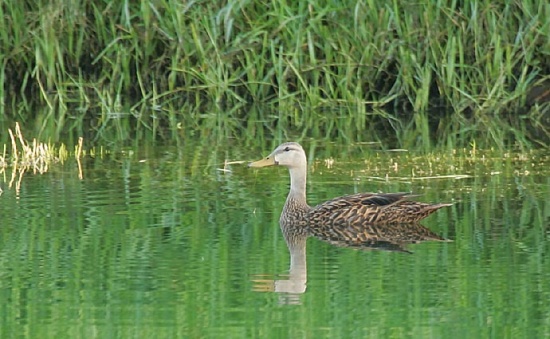| Line 4: | Line 4: | ||
Photo taken: Polk County, Florida | Photo taken: Polk County, Florida | ||
| − | The Mottled Duck (Anas fulvigula) or Mottled Mallard is a medium-sized dabbling duck. It is intermediate in appearance between female Mallard and American Black Duck. It is closely related to those species, and is sometimes considered a subspecies of the former, but this is inappropriate (see below). | + | The Mottled Duck (Anas fulvigula) or Mottled Mallard is a medium-sized dabbling duck. It is intermediate in appearance between female Mallard and American Black Duck. It is closely related to those species, and is sometimes considered a subspecies of the former, but this is inappropriate (see below). The adult Mottled Duck is 55 cm (15 inches) long. It has a dark body, lighter head and neck, orange legs and dark eyes. Both sexes have a shiny green-blue speculum (wing patch), which is not bordered with white as with the Mallard. Male and female are similar, but the male's bill is bright yellow, whereas the female's has a greenish yellow hue. |
| + | The plumage is darker than in female Mallards, especially at the tail, and the bill is yellower. In flight, the lack of a white border to the speculum is a key difference. The American Black Duck is darker than Mottled Ducks, and has a bluer wing patch. | ||
| + | ==Distribution== | ||
There are two distinct populations of Mottled Ducks. One population lives on the Gulf of Mexico coast between Alabama and Tamaulipas (Mexico); outside the breeding season individual birds may venture as far south as to Veracruz. The other is resident in central and south Florida and occasionally strays north to Georgia. | There are two distinct populations of Mottled Ducks. One population lives on the Gulf of Mexico coast between Alabama and Tamaulipas (Mexico); outside the breeding season individual birds may venture as far south as to Veracruz. The other is resident in central and south Florida and occasionally strays north to Georgia. | ||
| − | + | ==Taxonomy== | |
| − | + | ==Habitat== | |
| − | + | ==Behaviour== | |
| − | |||
| − | |||
Mottled Ducks feed by dabbling in shallow water, and grazing on land. They mainly eat plants, but also some molluscs and aquatic insects. This duck is fairly common within its restricted range; they are resident all-year round and do not migrate. The breeding habitat is coastal marshes. The nest is built on the ground amongst vegetation. | Mottled Ducks feed by dabbling in shallow water, and grazing on land. They mainly eat plants, but also some molluscs and aquatic insects. This duck is fairly common within its restricted range; they are resident all-year round and do not migrate. The breeding habitat is coastal marshes. The nest is built on the ground amongst vegetation. | ||
Revision as of 16:14, 7 June 2007
- Anas fulvigula
Identification
Photo taken: Polk County, Florida
The Mottled Duck (Anas fulvigula) or Mottled Mallard is a medium-sized dabbling duck. It is intermediate in appearance between female Mallard and American Black Duck. It is closely related to those species, and is sometimes considered a subspecies of the former, but this is inappropriate (see below). The adult Mottled Duck is 55 cm (15 inches) long. It has a dark body, lighter head and neck, orange legs and dark eyes. Both sexes have a shiny green-blue speculum (wing patch), which is not bordered with white as with the Mallard. Male and female are similar, but the male's bill is bright yellow, whereas the female's has a greenish yellow hue.
The plumage is darker than in female Mallards, especially at the tail, and the bill is yellower. In flight, the lack of a white border to the speculum is a key difference. The American Black Duck is darker than Mottled Ducks, and has a bluer wing patch.
Distribution
There are two distinct populations of Mottled Ducks. One population lives on the Gulf of Mexico coast between Alabama and Tamaulipas (Mexico); outside the breeding season individual birds may venture as far south as to Veracruz. The other is resident in central and south Florida and occasionally strays north to Georgia.
Taxonomy
Habitat
Behaviour
Mottled Ducks feed by dabbling in shallow water, and grazing on land. They mainly eat plants, but also some molluscs and aquatic insects. This duck is fairly common within its restricted range; they are resident all-year round and do not migrate. The breeding habitat is coastal marshes. The nest is built on the ground amongst vegetation.




